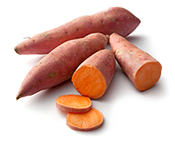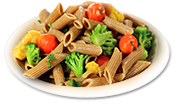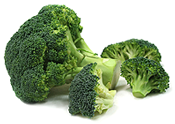Vegetables
Tips to Help You Eat Vegetables
-
In General:

- Buy fresh vegetables in season. They cost less and are likely to be at their peak flavor.
- Stock up on frozen vegetables for quick and easy cooking in the microwave.
- Buy vegetables that are easy to prepare. Pick up pre-washed bags of salad greens and add baby carrots or grape tomatoes for a salad in minutes. Buy packages of veggies such as baby carrots or celery sticks for quick snacks.
- Use a microwave to quickly “zap” vegetables. White or sweet potatoes can be baked quickly this way.
- Vary your veggie choices to keep meals interesting.
- Try crunchy vegetables, raw or lightly steamed.
-
For the Best Nutritional Value:

- Select vegetables with more potassium often, such as sweet potatoes, white potatoes, white beans, tomato products (paste, sauce, and juice), beet greens, soybeans, lima beans, spinach, lentils, and kidney beans.
- Sauces or seasonings can add calories, saturated fat, and sodium to vegetables. Use the Nutrition Facts label to compare the calories and % Daily Value for saturated fat and sodium in plain and seasoned vegetables.
- Prepare more foods from fresh ingredients to lower sodium intake. Most sodium in the food supply comes from packaged or processed foods.
- Buy canned vegetables labeled "reduced sodium," "low sodium," or "no salt added." If you want to add a little salt it will likely be less than the amount in the regular canned product.
-
At Meals:

- Plan some meals around a vegetable main dish, such as a vegetable stir-fry or soup. Then add other foods to complement it.
- Try a main dish salad for lunch. Go light on the salad dressing.
- Include a green salad with your dinner every night.
- Shred carrots or zucchini into meatloaf, casseroles, quick breads, and muffins.
- Include chopped vegetables in pasta sauce or lasagna.
- Order a veggie pizza with toppings like mushrooms, green peppers, and onions, and ask for extra veggies.
- Use pureed, cooked vegetables such as potatoes to thicken stews, soups and gravies. These add flavor, nutrients, and texture.
- Grill vegetable kabobs as part of a barbecue meal. Try tomatoes, mushrooms, green peppers, and onions.
-
Make Vegetables More Appealing:

- Many vegetables taste great with a dip or dressing. Try a low-fat salad dressing with raw broccoli, red and green peppers, celery sticks or cauliflower.
- Add color to salads by adding baby carrots, shredded red cabbage, or spinach leaves. Include in-season vegetables for variety through the year.
- Include beans or peas in flavorful mixed dishes, such as chili or minestrone soup.
- Decorate plates or serving dishes with vegetable slices.
- Keep a bowl of cut-up vegetables in a see-through container in the refrigerator. Carrot and celery sticks are traditional, but consider red or green pepper strips, broccoli florets, or cucumber slices.
-
Vegetable Tips for Children:

- Set a good example for children by eating vegetables with meals and as snacks.
- Let children decide on the dinner vegetables or what goes into salads.
- Depending on their age, children can help shop for, clean, peel, or cut up vegetables.
- Allow children to pick a new vegetable to try while shopping.
- Use cut-up vegetables as part of afternoon snacks.
- Children often prefer foods served separately. So, rather than mixed vegetables try serving two vegetables separately.
-
Keep It Safe:
- Rinse vegetables before preparing or eating them. Under clean, running water, rub vegetables briskly with your hands to remove dirt and surface microorganisms. Dry with a clean cloth towel or paper towel after rinsing.
- Keep vegetables separate from raw meat, poultry and seafood while shopping, preparing, or storing.
Key Consumer Message
Make half your plate fruits and vegetables.